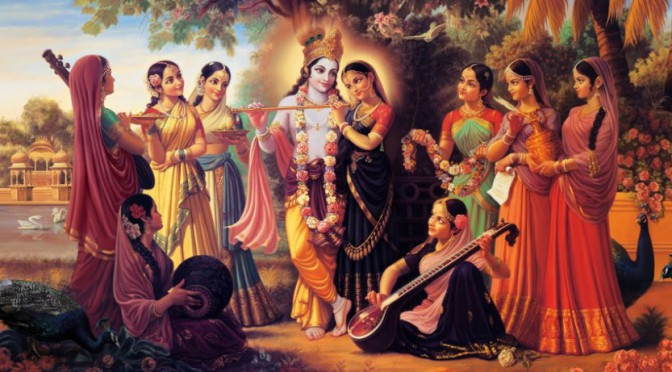Bhagwat Katha / Saptah
Shrimad Bhagwat Katha is the most sacred books of the Hindus. It gives a tremendous insight and an entirely new perspective to the person who hears the narrative. On hearing, a person is never the same. There is a complete transformation, literally a new birth. Atma (soul) by it’s own nature is sovereign – it cannot by nature be bound – whatever bondages felt are sheer illusions of the mind.

Shrimad Bhagwatam provides that light which enables Jeeva (human being) to experience the wonderful freedom of liberation. Shrimad Bhagwat Katha expresses this philosophy through the narration of the life stories of 24 incarnations of Lord Vishnu. Amongst these, the tenth volume of the Shrimad Bhagwatam narrates in infinite detail, the story of Lord Krishna. Since all 24 incarnations are of Lord Vishnu, it is a vitally important scripture for the Vaishnavas.
Benefits of Organizing Shrimad Bhagwat Katha ?
- For Health, Wealth & Prosperity
- For Your Spiritual Journey ( Bhagwat Prapti )
- To Attain Moksha
- To Please all your Pitra Devta
- For Peace of Good / Evil Spirit
- To Fulfil Desire ( Manokamna Poorti / Mannat )
Shiva Puran
A purana is a story about the deeds and life of a deity. Traditionally, there are 18 Puranas, and a few lesser Puranas or Upapuranas. The 18 major Puranas include the Skanda Purana, Padma Purana, Naradiya Purana, Shiv Puran, Varaha Purana, Vishnu Purana, Garuda Purana, Bhavishya Purana, Brahmavaivarta Purana, Kurma Purana, Agni Purana, Matsya Purana, Bhagavata Purana, Brahmanda Purana, Vamana Purana, Brahma Purana, Linga Purana, and Markandeya Purana.
The Shiva Purana as it exists now consists of around 24,000 slokas or verses, and is said to have been composed by sage Vyasa himself. According to the lore, the Shiva Purana originally consisted of 12 Samhitas or chapters, and 100,000 verses. However, only seven remain now, namely the Vidyesvara, Rudra, Satarudra, Kotirudra, Uma, Kailasa and Vayaviya Samhitas. Of these the Rudra Samhita is the largest and consists of five parts dealing with creation of the existence, the story of Sati and Shiva, the story of Parvati and Shiva, the birth and battles of Kumara or Skanda, and the battles of Shiva.
The seventh samhita is the Vayaviya. It has been suggested that this samhita included what has now become the Agni Purana, which was split of at some time in the past to form a separate purana.
Ganesh Puran
The Ganesha Purana is an ancient religious text that is solely dedicated to Lord Ganesha. It talks about stories, tales, historical events and religious rituals related to Ganesha. The Ganesha Purana is considered sacred by Ganapatayas but surprisingly it came into existence rather late. Religious experts and historians say that the two basic scriptures of Lord Ganesha came into being between 1300 and 1600 AD (although this is a matter of debate).Considering the span of the Hindu mythology, this can be considered late by some.
During the medieval ages the Ganapataya sect formed their own rituals and religious movement that was purely dedicated to their prime deity Lord Ganesha. It was during this time that the sect made the teachings of Ganesha Purana popular by preaching them. The Purana discussed in detail the stories that emphasized the importance and significance of Lord Ganesha and it also explained lord’s relationship with his devotees and fellow gods and goddess’. It is said that the Ganesha Purana is an Upapurana which means that it is a compilation of various religious texts.

